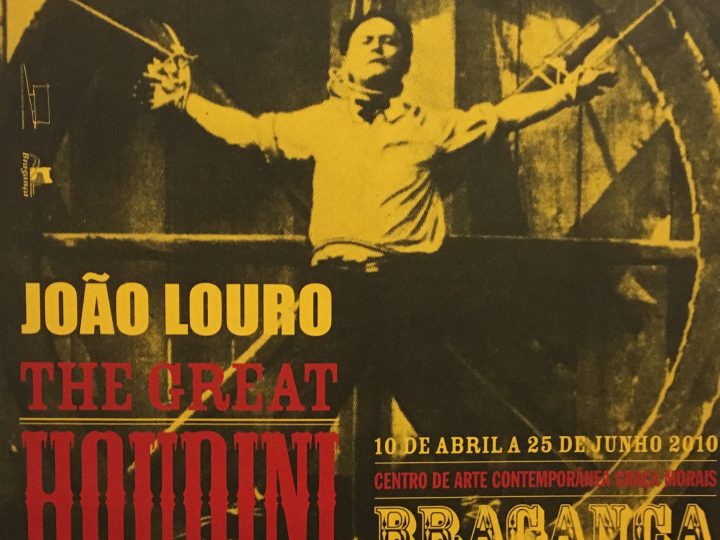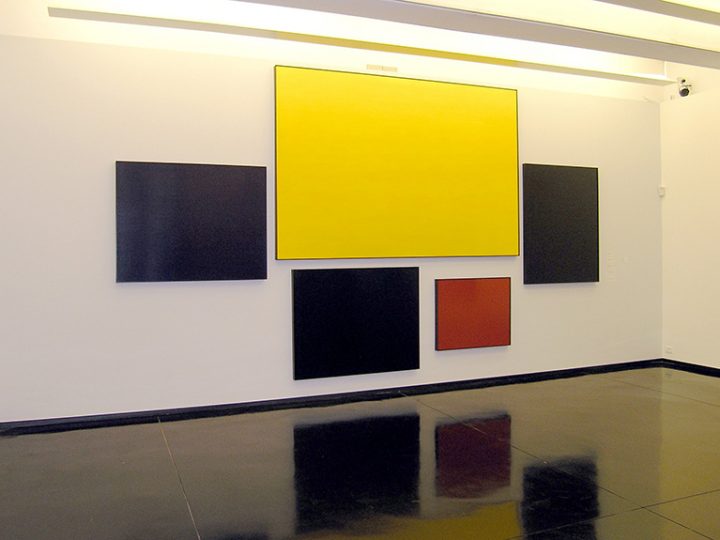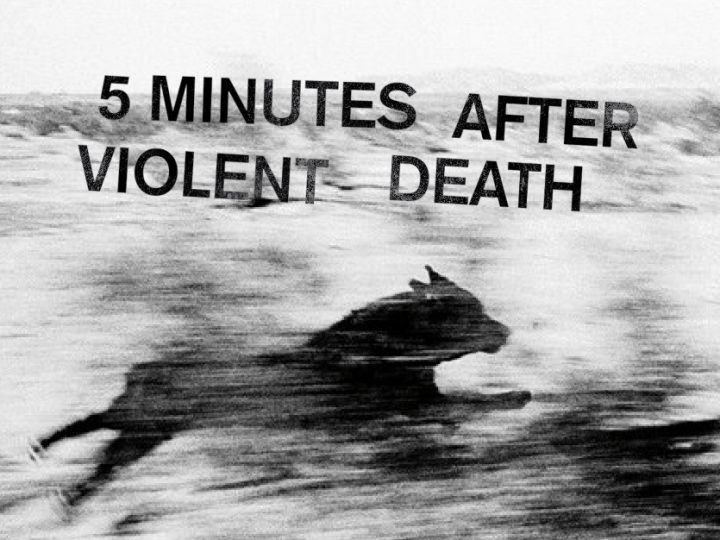
Carolina Grau (CG) – Why did you choose Johnny Cash, Elvis Presley, Roy Orbison as the title of the exhibition?
Joao Louro (JL) – I had some exhibitions, and projects in the USA, so I had been collecting information and ideas for a while. This was the right moment to work on my reflections about America. I organised these ideas by subjects, and I feel that music, pop culture and the 50’s with rock & roll and the beginning of the new era is a good starting point to think about the USA. My ideas began with these three icons of American culture.
CG – There is one work about Elvis Presley, titled Love Me Tender.
JL – I’m a deep fan of Elvis Presley. He is an icon. Actually, I got married in Las Vegas to the song ‘Love Me Tender’ sung by an Elvis Presley double. So I have a deep relationship with Elvis Presley and I wanted to share this feeling about global culture with the viewers.
CG – Let’s talk about the triptych The First Three Seconds Count of the Automatic Chronographer. This is composed of two variations of the American flag and a photograph of a cake-cutting ceremony of the atomic bomb. A fantastic photograph. It took me aback. After all the Blind Images this is the first time I’ve seen a photograph in your work.
JL –I collect images from newspapers and magazines and I have an important archive of them. At the same time I’m erasing images…
CG – Yes, you need to collect them in order to erase them. This image has a woman wearing a hat with the same shape as the mushroom cloud of the atomic bomb.
JL – This photograph is a very strange, deep and sordid image. It is a celebration of the beginning of the atomic age.
CG – You have written Sony at the bottom of the American flag. Why? Is it like an extra star?
JL – No. I feel that one day, in the future, countries could belong to multinational companies. Politics goes into strange directions. One day we could live in a country that belongs to a company.
CG – It almost happened in Iceland last week. The banks have collapsed and the country is in crisis. Probably one of the solutions will be selling the country’s assets to a company.
JL – I started to think about this work two years ago. Sometimes artists think about the future and a certain point these ideas become a reality.
CG – We are now in the most important month of American history since September 2001. On the last month we have seen American banks collapsing and also during this week we have seen the election of the first African-American President.
JL – Yes, the intellectuals call this the zeitgeist, the ‘spirit of the times’. Some artists work with this spirit of the time. America now is on the front line, everybody talks about America, and everybody wants to see what is going on after this. I have been working on this exhibition since before the election process began. Artists are like magnets. They attract some subjects.
CG – Or some subjects attract artists. When did you start to become fascinated by American culture?
JL –I have a strange and ambivalent relationship with America. I love and hate it at the same time. I have to face that it is the centre of the Western Global Society.
CG – Portugal faces America.
JL –Sometimes I say that the other side of the river, in front of Lisbon, is New York.
CG – The second flag in the triptych has a great many black stars on the enamel and Plexiglas background.
JL – For me it was a landscape full of stars, a wonderful starry summer night. I started to think about the American landscape but when I realised the image in my head it became much more a political rather than a romantic landscape. It began with a romantic approach, and ended as political issue.
CG – Also America represents stardom, it is the country where you can realise your dreams. Reach the stars.
JL – Stars are a real important image for America.
CG – Opposite the triptych you have Artificial Paradises (Ecstasy Samples), composed of different brand logos, including Nike, Lehman Brothers and Lucky Strike…
JL – I did some works about Artificial Paradises because of the book by Baudelaire. He speaks about the intoxication of opium, hashish and wine in the middle of the 19th century, and I realised we can relate this to a newer kind of artificial paradise in the contemporary world. For me the global brands are the new drugs.
CG – The dollar bills in In God We Trust were drawn during your InSite commission. Can you tell me about this project?
JL – InSite is a very important art project based in San Diego, California (USA) and Tijuana, Baja California (Mexico). The subject of the project is the relationship between USA and Mexico and I observed this relation during all the visits to both countries. They are like twins who don’t like each other. They need each other but they don’t want to recognize the fact. This is the bottom line of the project. My project began with a car that I bought in Mexico. It was a smashed-up European car, a trashed Jaguar. I covered it with gold leaf in Mexico and transformed it into a luxury item.
CG – Like adding a patina…
JL – Yes… Adding status. It is like a wedding ring, shiny and perfectly done. I took this new gold car and crossed the border, and I did a presentation in the Ferrari and Maserati showroom in La Jolla, one of the most fancy neighbourhood in San Diego. After I auctioned the car in a collector’s house in San Diego. I made money with the transformation of the trash into an artwork. I took the money and I made it back to Tijuana, to the school El Principito, in order to finish my project. With all that money I invited the kids to think about the relationship of the two countries and to do a visual exercise about it on the dollar bills. The next step was to spread the money in the USA and Mexico during the next few months. The dollars I’m presenting in this exhibition belong to this story.
CG – Another work in the show is called Pay Per View. My first thought was about watching porn on a flat screen hotel TV.
JL – Pay per view is for porno, important sport games and films. Perhaps in the future we could have art works in pay per view. Maybe one day you might need to pay per view your own work of art.
CG – When you stand in front Pay Per View you are reflected in the black surface. But you are also reflecting your own perceptions.
JL – It is like a black hole.
CG – Downstairs there is a new sculpture called Podium. It is painted black and supported by a car-jack. No one can stand on the 1st or 2nd platforms for the winners. You can only stand in 3rd place.
JL –I started thinking about meritocratic societies, in which you are promoted if you demonstrate talent. We don’t live in this kind of society. The podium is the Olympic podium and if you win a race you go to the first place. But with this podium you cannot occupy the 1st place.
CG –When you come inside the gallery you can see the sign Happy 80’s hung at the far end of the gallery. For our generation in Spain and Portugal the 80’s meant democracy, freedom and the economic boom.
JL –It was a kind of new and wonderful world. Now we face these dark clouds and I felt it was the right time to do something with the old times. So going back 20 years to these beautiful new opportunities, was like feeling the fresh air on the face and I wanted to talk about that feeling. I personally didn’t sell anything in those days. I just looked to the others selling and having exhibitions. Actually I started to work as an artist professionally in the 90’s so I belong to the crisis… The Gulf War started in those days.
CG –The title Lucy in the Sky with Diamonds is based on the Beatles song. You have written the chemical formula for LSD on it. In this work you seem to be moving away from perfect shiny monochromes and you’ve started drawing. There are even elements of collage. The finish is rougher.
JL – I have two different approaches. In one I want to give the viewer all the information immediately, with no distractions. You go straight to the subject. There are other works where I give all the information I can so the viewer can loose himself in the landscape. You discover new things wherever you look.
CG – The LSD formula is the real one?
JL – Yes. Sometimes I like to play with the possibilities of danger – of weapons, electricity, drugs… I like to walk that line.
CG – What does Le Lapin Agile mean?
JL – When I was doing the drawing of the Playboy rabbit I thought straight away of the Lapin Agile, this famous cabaret in Paris where Picasso and other artists went to have good time. This rabbit is so quick changing and always doing strange things, moving and transforming himself that I needed to call it Le Lapin Agile (Nimble Rabbit).
CG – When I think about the Playboy rabbit I always think about the bunny girls. In your drawings the rabbit has been mutated with company logos: we have the eye with the Chanel sign, another rabbit has the Maggi speech bubble and another has the Nike sign as a pipe. The Playboy drawings are very masculine.
JL – Chanel isn’t very masculine… The important thing is the transformation. By merging old things you can do something new. When I mix Chanel and the Playboy rabbit I created a new marriage and a new family of things began. That is the definition of “new” for me. Also I don’t want people to recognise this as design. Most of my works are related to the information people already have inside them. I don’t want to explain what Playboy is. Everybody knows already. You recognise it straight away but there is something strange in the image, and suddenly you see the difference. This shift is my goal. It’s like a virus. Inside this familiar image there is a virus and that information is a spark and the ignition of a thought. That is the spirit. This is a very important philosophical step for me.
The viewer must complete the work. The work isn’t finished until the viewer does it.
© Copyright of Joao Louro and Carolina Grau 2008
Possible notes:
1 – ‘Elvis performed “Love Me Tender” on the Ed Sullivan show on September 9, 1956, shortly before the single’s release and about a month before the movie, Love me Tender, was released, for which the song was originally recorded. On the following day, September 10, 1956, RCA received 1 million advance orders for the song, making it a gold record before it was even released. Presley would go on to make more than 30 films over the next 13 years and release hundreds of soundtrack recordings; “Love Me Tender”, however, was the very first of these. The song hit #1 on the Billboard charts the week ending November 3, 1956, remaining in the position for 5 weeks.
2- Photograph taken in 1946. Admiral W.H.P. “Spike” Blandy, Mrs Blandy and Rear Admiral F.J. Lowry celebrate Operation Crossroads with an atomic cake. This photograph, entitled “Atomic Age Angel Food”, drew heavy criticism from throughout the nation and from around the word. The photograph was published in the Time Magazine in November 18, 1946.
3 – For more information go to http://www.insite05.org/
4 – Lapin Agile is a famous Montmartre cabaret, at 22 Rue des Saules, Paris. The cabaret was more than twenty years old when, in 1875, the artist Andre Gill painted the sign that was to suggest its permanent name. It was a picture of rabbit jumping out of a saucepan, and residents began calling their neighbourhood nightclub “Le Lapin à Gill”, “Gill’s rabbit”. Over time the name evolved into “Cabaret Au Lapin Agile”, or, the Nimble Rabbit Cabaret. At the turn of the twentieth century, the Lapin Agile was a favorite spot for struggling artists and writers, including Picasso, Modigliani, Apollinaire and Utrillo.



